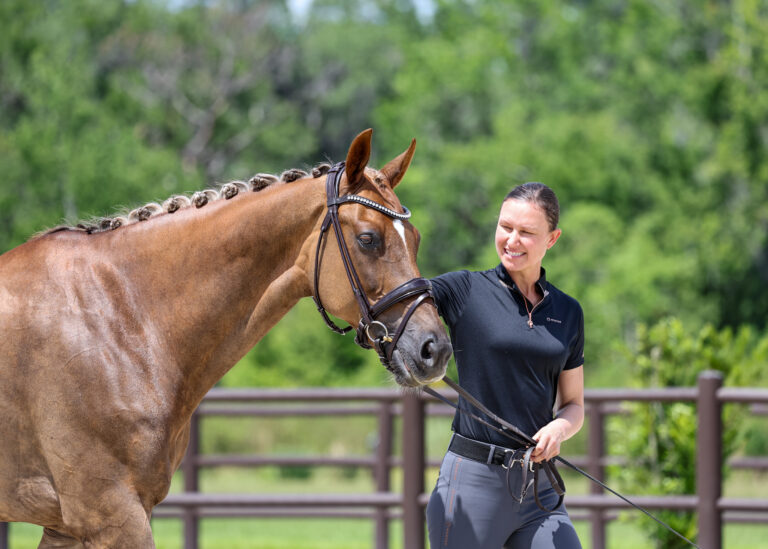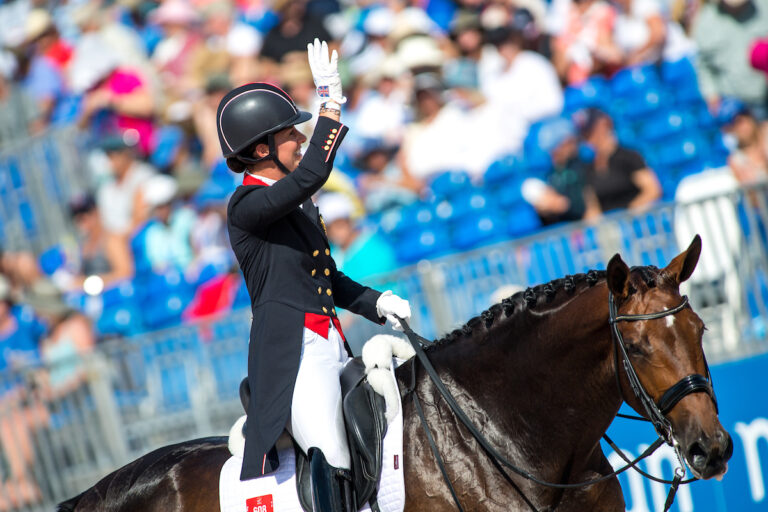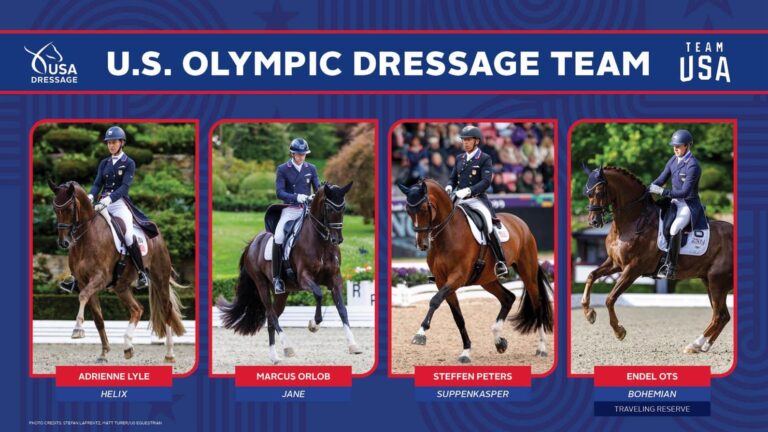This picture shows Lorene Kribs on Quinto XXIV, a 15-year-old Pure Spanish Horse. Lorene has owned Quinto for five years. They are showing Second Level and schooling Third Level.
Looking at this picture, I want to say, “Do not hold back your potential!”
Quinto is a “modern” Spanish horse with the ability to move big and elegantly with a lot of power from behind. He is beautifully presented, and this shows how much thought and effort Lorene puts into every detail.
When zooming into this picture and becoming very critical, one would wish that Quinto would not only be active behind but also lower his croup, show more lift of his shoulders and bring his nose forward slightly in front of the vertical line. Especially in the stage of training between Second and Third Level, the degree of collection will need exactly this.

Courtesy, Celine Bocchino
Rider’s Seat and Balance
Looking at the seat and balance of Lorene, I notice some parallels. I do not mind that she is sitting slightly forward in her upper body. I very much prefer this in an extension to the habit of leaning back. But looking closely, she is giving up the connection of her seat. Maintaining a deep but light seat in an extension is not easy. It requires a fair amount of suppleness and mobility in the hip joints.
When putting her leg on the horse, Lorene is shortening her leg position. Her hip, knee and ankle are showing tension, and her leg appears to be shortened. If Lorene kept her back elongated, extended her hip flexors and stretched her legs down (deepening the knee and ankle position), she would be able to support Quinto’s balance better. In turn, this would help him lift his shoulders and perform this exceptional extension with even more lightness and self-carriage.
Exercise for Positive Tension
To get a feel for this positive tension in her body and extending her hip flexors without hollowing her back, I suggest Lorene do a simple exercise on the ground.
Stand with slightly bent knees (like a riding position) and with one hand, touch the area where the spine is connected to the pelvis (the sacrum). The other hand slides down along the tummy muscles until it touches the pubic bone. Both hands should now be on the same horizontal line. If the back hand is higher, she needs to lift her pubic bone until she feels this alignment. In this position, the lumbar spine is straightened, and pressure on the lower back can be avoided.
Then, slowly start sinking down through the legs while keeping this alignment between her hands. If the back hand wants to come higher than her hand on the pubic bone, the pelvis is tilting forward. This causes either a forward upper body position or a hollow curve in the lower back. She will feel how this begins to stretch over her hip joints and how she needs to actively push down into her legs to be able to open the hips without tilting forward.
Next, while keeping the hands to feel the pelvis position, raise the heels and stand more on the balls of the feet. Alternate reaching one heel down while bending the other knee more forward. Switch the leg positions like stepping on the spot. To stay in balance, the back line of the leg muscles (especially the hamstring muscle group) needs to be activated.
Lowering the heel on the horse starts from much higher up than just the ankle and knee. To get the feel of lowering the ankle, this exercise can be performed with the front of her feet slightly higher, standing with the balls of her feet on a book or on a step. This helps the heel to stretch down without shifting weight backwards.
In the picture, her slightly forward upper body is keeping her hips in a flexed position. This does not allow her to reach down through her legs and support the self-carriage for the horse. If I could alter the picture, I would want to pull her legs a little longer and rotate the horse’s shoulders slightly upward until the nose is in front of the vertical and the rider is upright.
Bicycling Exercise
Riding without stirrups may be very beneficial for Lorene. It will automatically deepen the seat and allow more freedom for the hip joint.
“Bicycling” is an exercise to be performed first in walk and later in trot. It can be a great tool for her to achieve a deeper seat and independent, supple leg position. Lorene should alternate moving her knees up and down in the horse’s rhythm as if she was riding a bicycle. This can help like magic to connect her seat to her horse’s movement without being able to hold on or compensate with the legs.
This exercise will also correct the tilt and balance of her pelvis position. The rhythmic movement prevents tension build up in the hips and takes away the possibility of gripping and stabilizing her balance with the knees. Automatically, the rhythm will help her timing, and it will connect her directly with the horse’s movement. As a result, she can find her balance within the movement. This will support the horse’s balance, and she will become more elegant and effective in her seat.
The down movement of the bicycling will also allow Lorene to start releasing her hips and letting the horse’s movement move through her legs from her hips down to the ankles.
Standing in the Stirrups
After working without stirrups, I recommend riding with stirrups. Stand in the stirrups in a dressage position and find the balance point standing above the saddle. Staying in rising trot in this standing balance position for three to four strides will teach Lorene the automatic pattern of lengthening her leg while keeping a long upper body position. It will also give her a better feeling for grounding her seat through her legs into the stirrups when sitting down again.
Learning to ride with a long and effective leg will be a key point for Lorene to be successful at the next level and become more elegant and refined in her aids. This way, she will be able to help her horse, and Quinto will be able to show his great potential!
Both already look stunning and beautiful. Adding these details will hopefully help them both shine and enjoy their journey through the dressage levels even more!
About Susanne von Dietze

Susanne von Dietze is a leader in equestrian biomechanics. A physiotherapist, licensed Trainer A instructor and judge for dressage and show jumping, she gives lectures and seminars throughout the world, including at the prestigious German Riding Academy in Warendorf. She is a native of Germany and now lives with her husband and three children in Israel, where she competes at the international level. She is the author of two books on the biomechanics of riding: Balance in Movement and Rider and Horse, Back to Back.
Want to learn more from Susanne? Visit OnDemand.DressageToday.com and search for “Susanne Von Dietze” to see all her videos. Not a member? Sign up for a 10-day free trial with a subscription.
This article originally appeared in the Winter 2022 issue of Practical Horseman.











